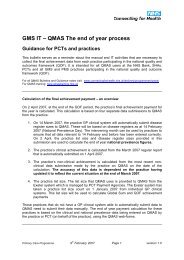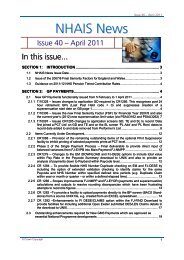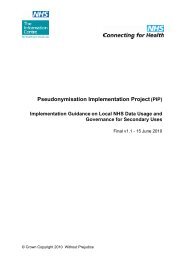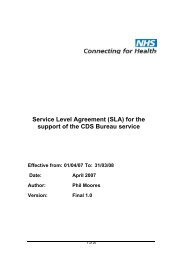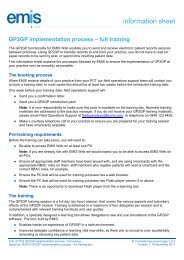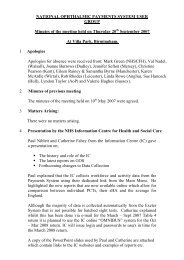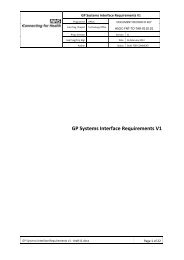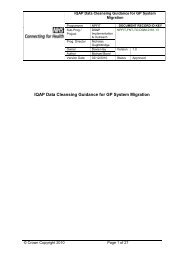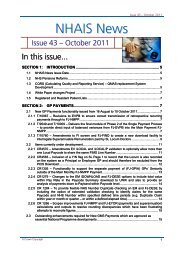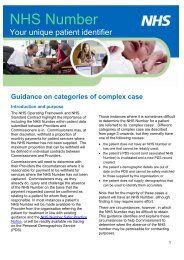SCG Clarification on Time Zone (PDF 134Kb) - Systems
SCG Clarification on Time Zone (PDF 134Kb) - Systems
SCG Clarification on Time Zone (PDF 134Kb) - Systems
Create successful ePaper yourself
Turn your PDF publications into a flip-book with our unique Google optimized e-Paper software.
<str<strong>on</strong>g>Clarificati<strong>on</strong></str<strong>on</strong>g> <strong>on</strong> <strong>Time</strong> Z<strong>on</strong>e<br />
Programme NPFIT Document Record ID Key<br />
Sub-Prog /<br />
Project<br />
Standards<br />
C<strong>on</strong>sulting<br />
Group<br />
NPFIT-FNT-TO-<str<strong>on</strong>g>SCG</str<strong>on</strong>g>-0005.14<br />
Prog. Director Ken Lunn Status Approved<br />
Owner Keith Naylor Versi<strong>on</strong> 1.0<br />
Author Davie Hay Versi<strong>on</strong> Date 30.01.09<br />
<str<strong>on</strong>g>Clarificati<strong>on</strong></str<strong>on</strong>g> <strong>on</strong> <strong>Time</strong> Z<strong>on</strong>e<br />
© Crown Copyright 2009
<str<strong>on</strong>g>Clarificati<strong>on</strong></str<strong>on</strong>g> <strong>on</strong> <strong>Time</strong> Z<strong>on</strong>e<br />
NPFIT-FNT-TO-<str<strong>on</strong>g>SCG</str<strong>on</strong>g>-0005.14 30.01.09 / Approved / 1.0<br />
Amendment History:<br />
Versi<strong>on</strong> Date<br />
Amendment History<br />
0.1 30.01.08 First draft for comment<br />
0.2 31.01.08 Sec<strong>on</strong>d draft for comment after feedback from Keith Naylor,<br />
Steve Bentley, Inderjit Singh, Bill Swire and Martin Tallis<br />
0.3 06.03.08 Third draft for comment after discussi<strong>on</strong> with Jas<strong>on</strong> Crellin and<br />
Kevin Sprague.<br />
0.4 18.03.08 Forth draft after discussi<strong>on</strong> with Keith Naylor, Steve Bentley,<br />
Martin Tallis, Kevin Sprague and Damian Murphy<br />
0.5 16.04.08 Fifth draft for comment including RFCs and analysis of times<br />
within MIM 7.2.00<br />
0.6 29.04.08 Sixth draft after team comments and feedback from Matt Barrow.<br />
0.7 07.05.08 Seventh draft after feedback from Martin Tallis.<br />
0.8 02.06.08 Eighth draft after feedback from Paul Stitt. Issued for review by<br />
Domain Teams for Impact Assessment <strong>on</strong> sending/receiving time<br />
z<strong>on</strong>e.<br />
0.9 12.08.08 Updated to correct BST examples and clarify display of time to<br />
be local time, after discussi<strong>on</strong> with Larry Selleck.<br />
0.10 03.11.08 Updated to widen scope bey<strong>on</strong>d MIM messaging and clarify<br />
display and audit.<br />
0.11 02.12.08 Updated after internal team review comments<br />
0.12 13.01.09 Updated after external review comments and from STIF<br />
0.13 21.01.09 Updated after clarificati<strong>on</strong> and comments from Bill Swire<br />
1.0 30.01.09 Approved versi<strong>on</strong><br />
Forecast Changes:<br />
Anticipated Change<br />
When<br />
Annual Review OR next MIM vehicle Jan 2010<br />
Reviewers:<br />
This document must be reviewed by the following:<br />
Name Signature Title / Resp<strong>on</strong>sibility Date Versi<strong>on</strong><br />
Martin Tallis SCR TA 02.12.08 0.11<br />
Andy Dickins<strong>on</strong> IG SME 19.12.08 0.11<br />
Matt Barrow Lead Messaging Architect 20.12.08 0.11<br />
Andrew<br />
Wheeler<br />
PACS Senior TA 08.01.09 0.11<br />
Bill Swire Lead Architect (Spine) 29.01.09 0.13<br />
© Crown Copyright 2009 Page 2 of 16
<str<strong>on</strong>g>Clarificati<strong>on</strong></str<strong>on</strong>g> <strong>on</strong> <strong>Time</strong> Z<strong>on</strong>e<br />
NPFIT-FNT-TO-<str<strong>on</strong>g>SCG</str<strong>on</strong>g>-0005.14 30.01.09 / Approved / 1.0<br />
Approvals:<br />
This document must be approved by the following:<br />
Name Signature Title / Resp<strong>on</strong>sibility Date Versi<strong>on</strong><br />
Keith Naylor<br />
Distributi<strong>on</strong>:<br />
LSPs<br />
ESPs<br />
BT NASP (Spine)<br />
BT NISP (N3)<br />
ATOS (Choose and Book)<br />
PACS<br />
Head of Data Standards<br />
and Products<br />
Implementati<strong>on</strong><br />
NHS C<strong>on</strong>necting for Health Technical Architects<br />
Comms and Messaging Implementati<strong>on</strong> Steering group (CMISG)<br />
Spine Technical Integrati<strong>on</strong> Forum (STIF)<br />
Technical Assurance Group (TAG)<br />
Document Status:<br />
This is a c<strong>on</strong>trolled document.<br />
30.01.09 0.13<br />
Whilst this document may be printed, the electr<strong>on</strong>ic versi<strong>on</strong> maintained in FileCM is<br />
the c<strong>on</strong>trolled copy. Any printed copies of the document are not c<strong>on</strong>trolled.<br />
Related Documents:<br />
These documents will provide additi<strong>on</strong>al informati<strong>on</strong>.<br />
Ref no Doc Reference Number Title Versi<strong>on</strong><br />
1 NPFIT-SHR-QMS-PRP-0015 Glossary of Terms<br />
C<strong>on</strong>solidated.doc<br />
2 NPFIT-FNT-TO-DPM-0725 Message Implementati<strong>on</strong> Manual<br />
(MIM)<br />
13<br />
7.2.02<br />
3 NPFIT-FNT-TO-TIN-1348 External Interface Specificati<strong>on</strong> 11.6<br />
4 AN 22/2007 CUI – Date and <strong>Time</strong> Input and<br />
Display for Clinical <strong>Systems</strong> within<br />
the NHS in England<br />
5 ISO 8601:2004 Data Elements and interchange<br />
formats – Informati<strong>on</strong> interchange –<br />
Representati<strong>on</strong> of dates and times<br />
1.2<br />
Jan 2009<br />
2004<br />
© Crown Copyright 2009 Page 3 of 16
<str<strong>on</strong>g>Clarificati<strong>on</strong></str<strong>on</strong>g> <strong>on</strong> <strong>Time</strong> Z<strong>on</strong>e<br />
NPFIT-FNT-TO-<str<strong>on</strong>g>SCG</str<strong>on</strong>g>-0005.14 30.01.09 / Approved / 1.0<br />
Glossary of Terms:<br />
List any new terms created in this document. Mail the NPO Quality Manager to have<br />
these included in the master glossary above [1].<br />
Term Acr<strong>on</strong>ym Definiti<strong>on</strong><br />
British Summer<br />
<strong>Time</strong><br />
Central Medicati<strong>on</strong><br />
Record<br />
BST<br />
CMR<br />
A central record populated by data from the Electr<strong>on</strong>ic<br />
Prescripti<strong>on</strong> Service as well as other sources with both<br />
prescribed and dispensed data.<br />
Data Set Change<br />
Notice<br />
External Interface<br />
Specificati<strong>on</strong><br />
Electr<strong>on</strong>ic Business<br />
using eXtensible<br />
Markup Language<br />
Greenwich Mean<br />
<strong>Time</strong><br />
the Internet<br />
Engineering Task<br />
Force<br />
Message<br />
Implementati<strong>on</strong><br />
Manual<br />
Pers<strong>on</strong>al Spine<br />
Informati<strong>on</strong><br />
Services<br />
DSCN<br />
EIS<br />
ebXML<br />
GMT<br />
IETF<br />
MIM<br />
PSIS<br />
A nati<strong>on</strong>al directive issued from the Informati<strong>on</strong> Standards<br />
Board for Health and Social Care, notifying organisati<strong>on</strong>s of<br />
mandatory and other changes to data collecti<strong>on</strong> requirements.<br />
A modular suite of specificati<strong>on</strong>s that enables enterprises of<br />
any size and in any geographical locati<strong>on</strong> to c<strong>on</strong>duct business<br />
over the Internet. Using ebXML, companies now have a<br />
standard method to exchange business messages, c<strong>on</strong>duct<br />
trading relati<strong>on</strong>ships, communicate data in comm<strong>on</strong> terms and<br />
define and register business processes.<br />
A term originally referring to mean solar time at the Royal<br />
Observatory, Greenwich in L<strong>on</strong>d<strong>on</strong>. It is now often used to<br />
refer to Coordinated Universal <strong>Time</strong> (UTC) when this is<br />
viewed as a <strong>Time</strong> z<strong>on</strong>e.<br />
The Internet Engineering Task Force (IETF) is a large open<br />
internati<strong>on</strong>al community of network designers, operators,<br />
vendors, and researchers c<strong>on</strong>cerned with the evoluti<strong>on</strong> of the<br />
Internet architecture and the smooth operati<strong>on</strong> of the Internet.<br />
The Services include a health record service to store and<br />
provide informati<strong>on</strong> such as summary or status informati<strong>on</strong>,<br />
event-based informati<strong>on</strong>, and n<strong>on</strong>-event related carer<br />
documentati<strong>on</strong>.<br />
Spine Spine The Spine is part of the NHS Care Records Service and<br />
supports systems and services including Pers<strong>on</strong>al<br />
Demographics Service, Pers<strong>on</strong>al Spine Informati<strong>on</strong> Service,<br />
Transacti<strong>on</strong> Messaging Service, Clinical Spine Applicati<strong>on</strong>,<br />
Spine Directory Service, Sec<strong>on</strong>dary Uses Service, Choose<br />
and Book, the Electr<strong>on</strong>ic Prescripti<strong>on</strong> Service,<br />
Summary Care<br />
Record<br />
SCR<br />
The electr<strong>on</strong>ic summary of a patient’s health records.<br />
Sec<strong>on</strong>dary Use<br />
Service<br />
SUS<br />
A system designed to provide management and clinical<br />
informati<strong>on</strong> based <strong>on</strong> a pseud<strong>on</strong>ymised set of NCR data. SUS<br />
is the means by which informati<strong>on</strong> and analysis will be<br />
available for sec<strong>on</strong>dary purposes like performance m<strong>on</strong>itoring,<br />
service planning, commissi<strong>on</strong>ing and clinical audit. It will also<br />
© Crown Copyright 2009 Page 4 of 16
<str<strong>on</strong>g>Clarificati<strong>on</strong></str<strong>on</strong>g> <strong>on</strong> <strong>Time</strong> Z<strong>on</strong>e<br />
NPFIT-FNT-TO-<str<strong>on</strong>g>SCG</str<strong>on</strong>g>-0005.14 30.01.09 / Approved / 1.0<br />
provide support to Payment by Results.<br />
Coordinated<br />
Universal <strong>Time</strong><br />
UTC<br />
A high-precisi<strong>on</strong> atomic time standard. UTC has uniform<br />
sec<strong>on</strong>ds defined by Internati<strong>on</strong>al Atomic <strong>Time</strong> with leap<br />
sec<strong>on</strong>ds announced at irregular intervals to compensate for<br />
the Earth's slowing rotati<strong>on</strong> and other discrepancies.<br />
© Crown Copyright 2009 Page 5 of 16
<str<strong>on</strong>g>Clarificati<strong>on</strong></str<strong>on</strong>g> <strong>on</strong> <strong>Time</strong> Z<strong>on</strong>e<br />
NPFIT-FNT-TO-<str<strong>on</strong>g>SCG</str<strong>on</strong>g>-0005.14 30.01.09 / Approved / 1.0<br />
C<strong>on</strong>tents<br />
1 Purpose ...............................................................................................................7<br />
1.1 Definiti<strong>on</strong>s ....................................................................................................7<br />
1.2 Further Enquiries..........................................................................................7<br />
2 Audience .............................................................................................................8<br />
3 Background .........................................................................................................8<br />
3.1 British Summer <strong>Time</strong>....................................................................................8<br />
4 <str<strong>on</strong>g>Clarificati<strong>on</strong></str<strong>on</strong>g>..........................................................................................................9<br />
4.1 MIM Defined Messaging...............................................................................9<br />
4.2 Display of <strong>Time</strong>...........................................................................................10<br />
4.2.1 Examples 10<br />
4.3 Audit Log <strong>Time</strong> ...........................................................................................11<br />
4.4 ebXML Messaging......................................................................................11<br />
4.5 Caveats ......................................................................................................11<br />
5 Migrati<strong>on</strong> Strategy .............................................................................................12<br />
A Appendix 1 - Additi<strong>on</strong>al Reference Materials.....................................................13<br />
B Appendix 2 – Nati<strong>on</strong>al Integrati<strong>on</strong> Centre (NIC) note - PC time z<strong>on</strong>e and<br />
timestamp in ebXML messaging...............................................................................14<br />
C Appendix 3 - MIM TS datatypes that MUST include the time Z<strong>on</strong>e offset .........16<br />
© Crown Copyright 2009 Page 6 of 16
<str<strong>on</strong>g>Clarificati<strong>on</strong></str<strong>on</strong>g> <strong>on</strong> <strong>Time</strong> Z<strong>on</strong>e<br />
NPFIT-FNT-TO-<str<strong>on</strong>g>SCG</str<strong>on</strong>g>-0005.14 30.01.09 / Approved / 1.0<br />
1 Purpose<br />
This document is designed to provide clear requirements <strong>on</strong> the usage of time fields<br />
within MIM defined message payloads, times in messages (ebXML) as well as Audit<br />
and appropriate outputs for use within and between NHS C<strong>on</strong>necting for Health<br />
(NHS CFH) compliant systems. The document will describe the perceived problem<br />
and seek to provide an appropriate soluti<strong>on</strong> with justificati<strong>on</strong>.<br />
1.1 Definiti<strong>on</strong>s<br />
Where used in this document set, the keywords must, should, may, must not and<br />
should not are to be interpreted as described in RFC 2119. 1<br />
• Must : This word, or the terms “required” or “shall”, means that the definiti<strong>on</strong><br />
is an absolute requirement of the specificati<strong>on</strong><br />
• Should: This word, or the adjective “recommended”, means that there may<br />
exist valid reas<strong>on</strong>s in particular circumstances to ignore a particular item, but<br />
the full implicati<strong>on</strong>s must be understood and carefully weighed before<br />
choosing a different course.<br />
• May: This word, or the adjective “opti<strong>on</strong>al”, means that an item is truly<br />
opti<strong>on</strong>al. One implementer may choose to include the item because a<br />
particular implementati<strong>on</strong> requires it, or because the implementer feels that it<br />
enhances the implementati<strong>on</strong> while another implementer may omit the same<br />
item. An implementati<strong>on</strong> which does not include a particular opti<strong>on</strong> must be<br />
prepared to interoperate with another implementati<strong>on</strong> which does include the<br />
opti<strong>on</strong>, perhaps with reduced functi<strong>on</strong>ality. In the same vein, an<br />
implementati<strong>on</strong> which does include a particular opti<strong>on</strong> must be prepared to<br />
interoperate with another implementati<strong>on</strong> which does not include the opti<strong>on</strong><br />
(except of course, for the feature the opti<strong>on</strong> provides).<br />
• Must not: This phrase, or the phrase “shall not” mean that the definiti<strong>on</strong> is an<br />
absolute prohibiti<strong>on</strong> of the specificati<strong>on</strong>.<br />
• Should not: This phrase, or the phrase “not recommended” mean that there<br />
may exist valid reas<strong>on</strong>s in particular circumstances when the particular<br />
behaviour is acceptable or even useful, but the full implicati<strong>on</strong>s should be<br />
understood and the case carefully weighed before implementing any<br />
behaviour described with this label.<br />
1.2 Further Enquiries<br />
Enquiries about the c<strong>on</strong>tents of this document, or any of the requirements within it<br />
should be sent to nhscfh.scg@nhs.net.<br />
The Standards C<strong>on</strong>sulting Group (<str<strong>on</strong>g>SCG</str<strong>on</strong>g>) informati<strong>on</strong> is posted at<br />
http://www.c<strong>on</strong>nectingforhealth.nhs.uk/systemsandservices/data/scg.<br />
1 http://www.faqs.org/rfcs/rfc2119.html<br />
© Crown Copyright 2009 Page 7 of 16
<str<strong>on</strong>g>Clarificati<strong>on</strong></str<strong>on</strong>g> <strong>on</strong> <strong>Time</strong> Z<strong>on</strong>e<br />
NPFIT-FNT-TO-<str<strong>on</strong>g>SCG</str<strong>on</strong>g>-0005.14 30.01.09 / Approved / 1.0<br />
2 Audience<br />
These requirements are aimed at all systems suppliers i.e. LSPs, ESPs, BT NASP<br />
(Spine), BT NISP (N3) and ATOS (Choose and Book).<br />
3 Background<br />
It has been identified that there is a lack of clear guidance in the usage of date/time<br />
fields within the message payloads as defined in NHS CFH MIM publicati<strong>on</strong>s.<br />
Evidence suggests that vendor systems are populating the fields with 'local time'<br />
values which may be incorrectly interpreted by receiving systems. The systems are<br />
especially vulnerable during the changeovers to British Summer <strong>Time</strong> 2 . The<br />
Standards C<strong>on</strong>sulting Group (<str<strong>on</strong>g>SCG</str<strong>on</strong>g>) was asked by LSP representatives at a Spine<br />
Technical Integrati<strong>on</strong> Forum to clarify the use of UTC (Coordinated Universal <strong>Time</strong>) /<br />
local time in message payload.<br />
Accurate recording of time is vital not <strong>on</strong>ly for clinical records but also scheduling and<br />
booking for example.<br />
It is needed to support:<br />
• Recording of clinical events in a medico legal compliant manner<br />
• To arrange clinical events in chr<strong>on</strong>ological order<br />
• To calculate time differentials<br />
o Medicati<strong>on</strong> administrati<strong>on</strong>s<br />
o <strong>Time</strong> related pathology results e.g. serum drug levels<br />
• Technical interoperability, e.g. retries not being sent until an hour later due to<br />
UTC/BST discrepancies<br />
It is understood that current systems are not populating clinical records with time in a<br />
c<strong>on</strong>sistent manner. Currently the recommendati<strong>on</strong> is to assume that time recorded in<br />
messages is UTC unless stated. When investigating any clinical errors it is important<br />
to remember that the time displayed may be the local time of the displaying system<br />
rather than that of the source system.<br />
<strong>Time</strong> is subject to change depending up<strong>on</strong> where and when it is recorded. e.g.<br />
different time z<strong>on</strong>es, daylight saving time i.e. British Summer <strong>Time</strong> (BST). It is<br />
therefore essential that the time z<strong>on</strong>e offset is recorded and correct time is made<br />
available to clinicians.<br />
3.1 British Summer <strong>Time</strong><br />
Since 1981 EC Directives have prescribed the start and end dates of summer time in<br />
all Member States. There have to date been eight Directives which have set<br />
summer-time arrangements for fixed periods. The Summer <strong>Time</strong> Act 1972 sets the<br />
appropriate dates in the UK and summer-time orders have been made as necessary<br />
to implement the European Directives. The “9th EC Directive” prescribes the start<br />
2 http://www.berr.gov.uk/employment/bank-public-holidays/bst/page12528.html<br />
© Crown Copyright 2009 Page 8 of 16
<str<strong>on</strong>g>Clarificati<strong>on</strong></str<strong>on</strong>g> <strong>on</strong> <strong>Time</strong> Z<strong>on</strong>e<br />
NPFIT-FNT-TO-<str<strong>on</strong>g>SCG</str<strong>on</strong>g>-0005.14 30.01.09 / Approved / 1.0<br />
and end dates of summer time as the last Sundays in March and October<br />
respectively, starting at 1:00am GMT.<br />
Implementati<strong>on</strong> of the 9th Directive in the UK is through an Order in Council under<br />
secti<strong>on</strong> 2(2) of the European Communities Act 1972, which amended the relevant<br />
secti<strong>on</strong>s of the Summer <strong>Time</strong> Act 1972. The Order came into force <strong>on</strong> 11 March<br />
2002.<br />
In the UK the dates for British Summer <strong>Time</strong> are published by the Department for<br />
Business Enterprise and Regulatory Reform 3 .<br />
4 <str<strong>on</strong>g>Clarificati<strong>on</strong></str<strong>on</strong>g><br />
The NASP provides a Network <strong>Time</strong> Server that is coordinated to within 250<br />
millisec<strong>on</strong>ds of GMT. (Ref. Schedule 1.1, 730.103.1) GMT (Greenwich Mean <strong>Time</strong>)<br />
is equivalent to UTC. Spine subsystems are coordinated with this time server.<br />
All suppliers are c<strong>on</strong>tractually required to “ensure that all system clocks provided or<br />
utilised as part of the Service shall be synchr<strong>on</strong>ised to within 250 millisec<strong>on</strong>ds of the<br />
NASP-provided Network <strong>Time</strong> Servers.” (Ref. Schedule 1.7, 730.103.1)<br />
The MIM states - the timeStamp is sent in the "value" attribute of the Point in <strong>Time</strong><br />
(TS) data type. <strong>Time</strong> stamp informati<strong>on</strong> is sent in a format that is simplest for the<br />
XML schema to validate, as follows:<br />
• YYYYMMDDHHMMSS[+|-ZZzz], where YYYY is the year, MM the m<strong>on</strong>th, DD the<br />
day, HH the hour, MM the minutes, SS the sec<strong>on</strong>ds and +|-ZZzz is the time z<strong>on</strong>e<br />
offset in hours and minutes.<br />
The External Interface Specificati<strong>on</strong> versi<strong>on</strong> 11.6 part 2 states in secti<strong>on</strong> 2.9.1<br />
Distributed <strong>Time</strong>, that:<br />
• All Spine servers are based up<strong>on</strong> GMT/UTC.<br />
• Note that all transport related ‘time’ attributes, i.e. all times in the ebXML headers,<br />
HL7 Wrapper and WS-Addressing headers, MUST be provided in GMT / UTC.<br />
4.1 MIM Defined Messaging<br />
In order to avoid the possibility of misinterpretati<strong>on</strong> by receiving systems the sender<br />
must adhere to the following rules:<br />
• As per IETF RFC 3339, where the time in UTC is known but the offset to local<br />
time is unknown it must be represented with an offset of “-0000”. 4<br />
o This is of particular importance where local time is passed to the SPINE<br />
(e.g. PSIS, SUS, SCR, CMR)<br />
• Where precisi<strong>on</strong> of a time stamp includes hours, the time stamp must include the<br />
time z<strong>on</strong>e offset<br />
3 http://www.berr.gov.ukemployment/bank-public-holidays/bst/page12528.html<br />
4 http://www.ietf.org/rfc/rfc3339.txt see also http://www.faqs.org/rfcs/rfc2822.html<br />
© Crown Copyright 2009 Page 9 of 16
<str<strong>on</strong>g>Clarificati<strong>on</strong></str<strong>on</strong>g> <strong>on</strong> <strong>Time</strong> Z<strong>on</strong>e<br />
NPFIT-FNT-TO-<str<strong>on</strong>g>SCG</str<strong>on</strong>g>-0005.14 30.01.09 / Approved / 1.0<br />
• Whether time is recorded in UTC, GMT or BST the time z<strong>on</strong>e offset must be<br />
stated<br />
• <strong>Time</strong> z<strong>on</strong>e offset must be specified for all the following TS values in order to<br />
avoid a significant loss of precisi<strong>on</strong> when TS values are compared:<br />
o activity<strong>Time</strong><br />
o availability<strong>Time</strong><br />
o effective<strong>Time</strong><br />
o expirati<strong>on</strong><strong>Time</strong><br />
and the participati<strong>on</strong> times<br />
• Appendix 3 c<strong>on</strong>tains the list of TS datatypes where <strong>Time</strong> z<strong>on</strong>e must be specified.<br />
Note. In an administrative data c<strong>on</strong>text, some time values do not carry a time z<strong>on</strong>e.<br />
For example, it would be incorrect to specify time z<strong>on</strong>e offset for a date of birth or<br />
death in administrative data, since this may effectively change the date when<br />
c<strong>on</strong>verted into other time z<strong>on</strong>es. For such administrative data local time should be<br />
used.<br />
4.2 Display of <strong>Time</strong><br />
To avoid c<strong>on</strong>fusi<strong>on</strong> and clinical errors the display of time must be clearly displayed in<br />
local time suitable for the c<strong>on</strong>suming user’s perspective, which may include<br />
accounting for BST as well as translating UTC to local time.<br />
Standards relating to the input and display of date and time informati<strong>on</strong> have been<br />
developed by the Comm<strong>on</strong> User Interface (CUI) programme. 5 Advance Notificati<strong>on</strong><br />
(AN) 22/2007 is the advance notificati<strong>on</strong> for CUI – Date and <strong>Time</strong> Input and Display<br />
for Clinical <strong>Systems</strong> within the NHS in England, provides the advance notificati<strong>on</strong> of<br />
the requirements. 6<br />
4.2.1 Examples<br />
GMT example:<br />
Message<br />
Display Example<br />
20071215102746+0000<br />
20071215102746+00 15 Dec 2007 10:27:46<br />
5 http://www.cui.nhs.uk/<br />
6 http://www.c<strong>on</strong>nectingforhealth.nhs.uk/dscn/dscn-2009/advance/AN%2022-2007.pdf<br />
© Crown Copyright 2009 Page 10 of 16
<str<strong>on</strong>g>Clarificati<strong>on</strong></str<strong>on</strong>g> <strong>on</strong> <strong>Time</strong> Z<strong>on</strong>e<br />
NPFIT-FNT-TO-<str<strong>on</strong>g>SCG</str<strong>on</strong>g>-0005.14 30.01.09 / Approved / 1.0<br />
BST example:<br />
Message<br />
Display Example<br />
20070615102746+0100<br />
20070615102746+01 15 Jun 2007 10:27:46<br />
Note. Examples from when BST began and ended in 2007, remembering that clocks<br />
change at 1:00am GMT.<br />
Message<br />
20070325012746+0100<br />
20070325012746+01<br />
Display Example<br />
25 Mar 2007 01:27:46<br />
Message<br />
20071028012746+0100<br />
20071028012746+01<br />
20071028012746+0000<br />
20071028012746+00<br />
Display Example<br />
28 Oct 2007 01:27:46<br />
28 Oct 2007 01:27:46<br />
4.3 Audit Log <strong>Time</strong><br />
Audit timestamps must be recorded using the system time i.e. UTC.<br />
To avoid c<strong>on</strong>fusi<strong>on</strong> and governance errors the display of audit log time must be<br />
clearly displayed in local time suitable for the c<strong>on</strong>suming user’s perspective, which<br />
may include accounting for BST as well as translating UTC to local time.<br />
4.4 ebXML Messaging<br />
The Nati<strong>on</strong>al Integrati<strong>on</strong> Centre (NIC) has provided the note in Appendix 2 <strong>on</strong> the<br />
use of BST timestamps in ebXML messages sent to Spine.<br />
4.5 Caveats<br />
The following excepti<strong>on</strong>s / caveats apply:<br />
• Choose and Book always submits times as local time. As such local systems (e.g.<br />
slot polls and slot requests) all use local time<br />
• Choose and Book passes times to the Sec<strong>on</strong>dary Uses Service as local time<br />
• Pers<strong>on</strong>al Demographics Service records local time (i.e. date <strong>on</strong>ly not time) as<br />
business effective dates.<br />
© Crown Copyright 2009 Page 11 of 16
<str<strong>on</strong>g>Clarificati<strong>on</strong></str<strong>on</strong>g> <strong>on</strong> <strong>Time</strong> Z<strong>on</strong>e<br />
NPFIT-FNT-TO-<str<strong>on</strong>g>SCG</str<strong>on</strong>g>-0005.14 30.01.09 / Approved / 1.0<br />
5 Migrati<strong>on</strong> Strategy<br />
It is realised that there are a number of systems already utilising messages with time<br />
fields and have not implemented the time z<strong>on</strong>e offset indicator. Therefore the<br />
following migrati<strong>on</strong> plan is required:<br />
• Existing messages (prior to and including MIM 7.2.02 / EIS 11.6) should remain<br />
as is<br />
• When a system c<strong>on</strong>nects to the Spine using the MIM vehicle after 7.2.02 / EIS<br />
after 11.6 then the time z<strong>on</strong>e offset must be stated in line with Secti<strong>on</strong> 4.<br />
• When a system c<strong>on</strong>nects to the Spine using a later MIM / EIS vehicle than<br />
previously then the time z<strong>on</strong>e offset should be stated in line with Secti<strong>on</strong> 4.<br />
• Where the time z<strong>on</strong>e offset is not stated then UTC should be assumed.<br />
• Receiving systems must accept, process and display the time z<strong>on</strong>e offset in a<br />
manner which is both safe from a clinical and governance perspective and in line<br />
with Secti<strong>on</strong> 4.<br />
© Crown Copyright 2009 Page 12 of 16
<str<strong>on</strong>g>Clarificati<strong>on</strong></str<strong>on</strong>g> <strong>on</strong> <strong>Time</strong> Z<strong>on</strong>e<br />
NPFIT-FNT-TO-<str<strong>on</strong>g>SCG</str<strong>on</strong>g>-0005.14 30.01.09 / Approved / 1.0<br />
A Appendix 1 - Additi<strong>on</strong>al Reference Materials<br />
Comm<strong>on</strong> User Interface (CUI) programme<br />
http://www.cui.nhs.uk/<br />
Data Set Change Notice 22/2007 – Advance<br />
Notice for Comm<strong>on</strong> User Interface Date and <strong>Time</strong><br />
Input and Display for Clinical <strong>Systems</strong> within the<br />
NHS in England<br />
http://www.c<strong>on</strong>nectingforhealth.nhs.uk/dscn/dscn-<br />
2009/advance/AN%2022-2007.pdf<br />
Department for Business, Enterprise and<br />
Regulatory Reform – British Summer <strong>Time</strong><br />
timetable<br />
http://www.berr.gov.uk/employment/bank-publicholidays/bst/page12528.html<br />
RFC 2119 - Key words for use in RFCs to<br />
Indicate Requirement Levels<br />
http://www.faqs.org/rfcs/rfc2119.html<br />
RFC 2822 – Internet Message Format<br />
http://www.faqs.org/rfcs/rfc2822.html<br />
IETF RFC 3339 – Date and <strong>Time</strong> <strong>on</strong> the Internet<br />
– <strong>Time</strong>stamps<br />
http://www.ietf.org/rfc/rfc3339.txt<br />
© Crown Copyright 2009 Page 13 of 16
<str<strong>on</strong>g>Clarificati<strong>on</strong></str<strong>on</strong>g> <strong>on</strong> <strong>Time</strong> Z<strong>on</strong>e<br />
NPFIT-FNT-TO-<str<strong>on</strong>g>SCG</str<strong>on</strong>g>-0005.14 30.01.09 / Approved / 1.0<br />
B Appendix 2 – Nati<strong>on</strong>al Integrati<strong>on</strong> Centre (NIC) note - PC<br />
time z<strong>on</strong>e and timestamp in ebXML messaging<br />
This is a note for the STIF issue <strong>on</strong> the use of BST timestamps in ebXML messages sent to<br />
Spine. It relates to the populati<strong>on</strong> of the ebXML "<strong>Time</strong>stamp" element:<br />
2007-05-03T09:45:40Z<br />
This is defined in the OASIS ebXML 2.0 standard (secti<strong>on</strong> 3.1.6.2, p21) as using the UTC<br />
<strong>Time</strong> z<strong>on</strong>e (or "Zulu", hence the "Z" in the example above). The comm<strong>on</strong> assumpti<strong>on</strong> of UTC<br />
is critical because the same standard defines (secti<strong>on</strong>s 6.4.5 and 6.4.6, both <strong>on</strong> p39) that the<br />
value of the <strong>Time</strong>stamp element is the basis for the calculati<strong>on</strong> of <strong>Time</strong>ToLive and<br />
PersistDurati<strong>on</strong> c<strong>on</strong>tract properties in reliable messaging.<br />
TMS is known to be a correct implementati<strong>on</strong> of these parts of the ebXML specificati<strong>on</strong>.<br />
It is known that <strong>on</strong> at least some platforms (certainly Sun Java 1.5+ <strong>on</strong> Microsoft Windows<br />
XP - other combinati<strong>on</strong>s are currently unexplored), an error in the presentati<strong>on</strong> of time from<br />
the operating system results in <strong>Time</strong>stamp values being emitted that are <strong>on</strong>e hour out, when<br />
daylight savings time is in force.<br />
On Windows XP, the "Date and <strong>Time</strong>" c<strong>on</strong>trol panel applet, <strong>on</strong> the "<strong>Time</strong> Z<strong>on</strong>e" tab, offers<br />
the opti<strong>on</strong> to "Automatically adjust clock for daylight savings time"<br />
Selecting this results in Java's call to Calendar.get<strong>Time</strong>() returning the daylight savings time<br />
even when the programmer has explicitly requested an instance of Calendar for the "Zulu"<br />
<strong>Time</strong> z<strong>on</strong>e:<br />
© Crown Copyright 2009 Page 14 of 16
<str<strong>on</strong>g>Clarificati<strong>on</strong></str<strong>on</strong>g> <strong>on</strong> <strong>Time</strong> Z<strong>on</strong>e<br />
NPFIT-FNT-TO-<str<strong>on</strong>g>SCG</str<strong>on</strong>g>-0005.14 30.01.09 / Approved / 1.0<br />
<strong>Time</strong> z<strong>on</strong>e tz = <strong>Time</strong> z<strong>on</strong>e.get<strong>Time</strong> z<strong>on</strong>e("Zulu");<br />
Calendar c = Calendar.getInstance(tz, Locale.UK);<br />
Date d = c.get<strong>Time</strong>();<br />
When the "Automatically adjust..." checkbox is unselected, the call returns the correct Zulu<br />
time as requested.<br />
It is currently uninvestigated, the extent to which this applies to other executi<strong>on</strong> envir<strong>on</strong>ments<br />
<strong>on</strong> Windows, or to Java <strong>on</strong> other operating systems. However, it must be recommended that<br />
<strong>on</strong> all Microsoft Windows systems that send messages to Spine, the "Automatically adjust..."<br />
opti<strong>on</strong> is turned off.<br />
© Crown Copyright 2009 Page 15 of 16
<str<strong>on</strong>g>Clarificati<strong>on</strong></str<strong>on</strong>g> <strong>on</strong> <strong>Time</strong> Z<strong>on</strong>e<br />
NPFIT-FNT-TO-<str<strong>on</strong>g>SCG</str<strong>on</strong>g>-0005.14 30.01.09 / Approved / 1.0<br />
C Appendix 3 - MIM TS datatypes that MUST include the<br />
time Z<strong>on</strong>e offset<br />
The following analysis is baselined from MIM 7.2.00 however the requirements are<br />
appropriate regardless of the versi<strong>on</strong> of MIM.<br />
S:\Standards<br />
C<strong>on</strong>sultants Group\De<br />
© Crown Copyright 2009 Page 16 of 16



